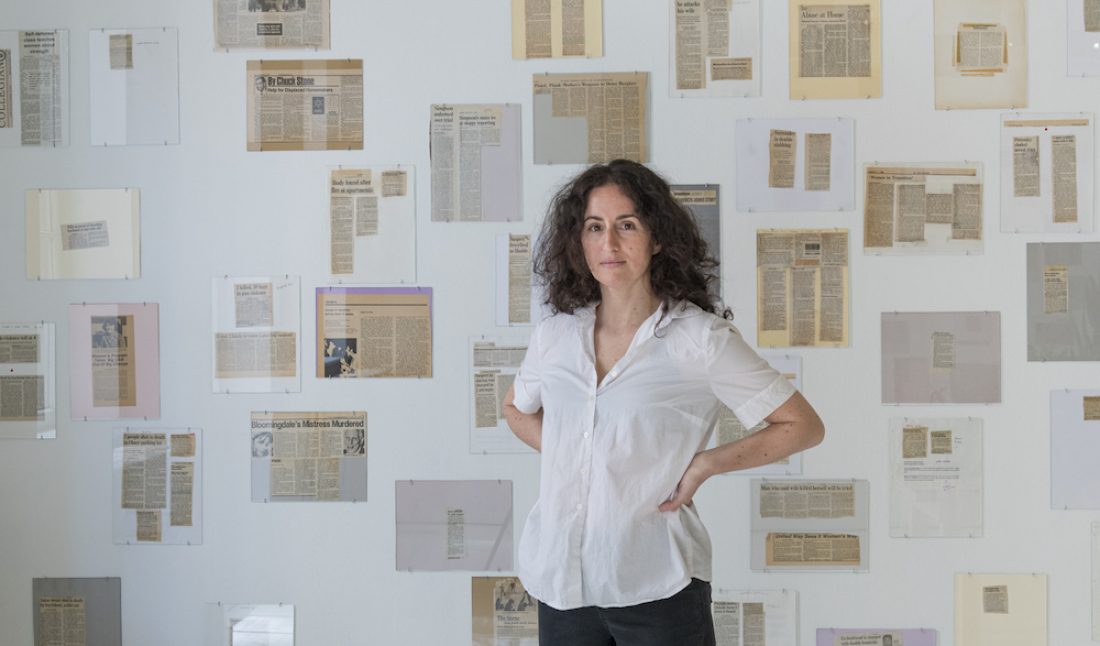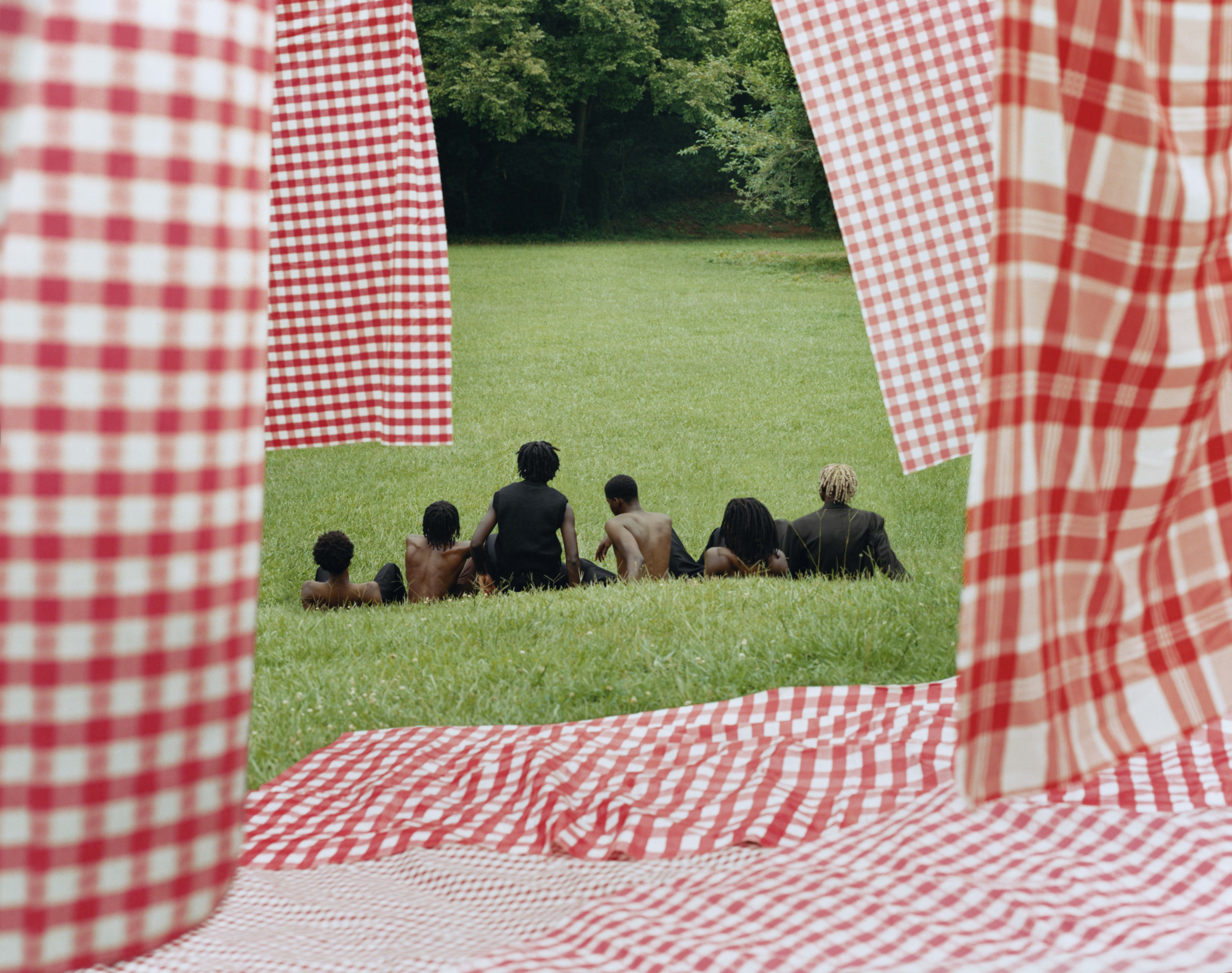Carmen Winant’s “A Brand New End: Survival and Its Pictures” was recently on view at The Print Center in Philadelphia, PA (April 15—July 16, 2022). The exhibition was the result of the artist delving into the archives of two organizations: Women in Transition (WIT) founded in Philadelphia and the National Coalition Against Domestic Violence (NCADV) based in Denver, CO.
On the first floor, bulletin boards like you would see in a school or community center were taped with photographs and images found in the archives—documentation of meetings and gatherings, catalog shots of women at work in a variety of jobs, staged photoshoots of the aftermath of domestic abuse. Two boards, filled with sun-faded, colorful construction paper and the remains of painter’s tape, with marked traces of other ephemera once-pinned to them, are photos of a sunset and sunrise respectively. A powerful moment of reflection, we might imagine, after the photographer’s brave choice to start anew.
Winant describes herself as a “lapsed photographer,” having moved from taking images of found photos to putting her camera aside and working with what she realized she found most interesting: the image object. Based in Columbus, OH, she has dealt with the subject and material of birth stories, instructional guides to craft, female pleasure, women at work, and more.
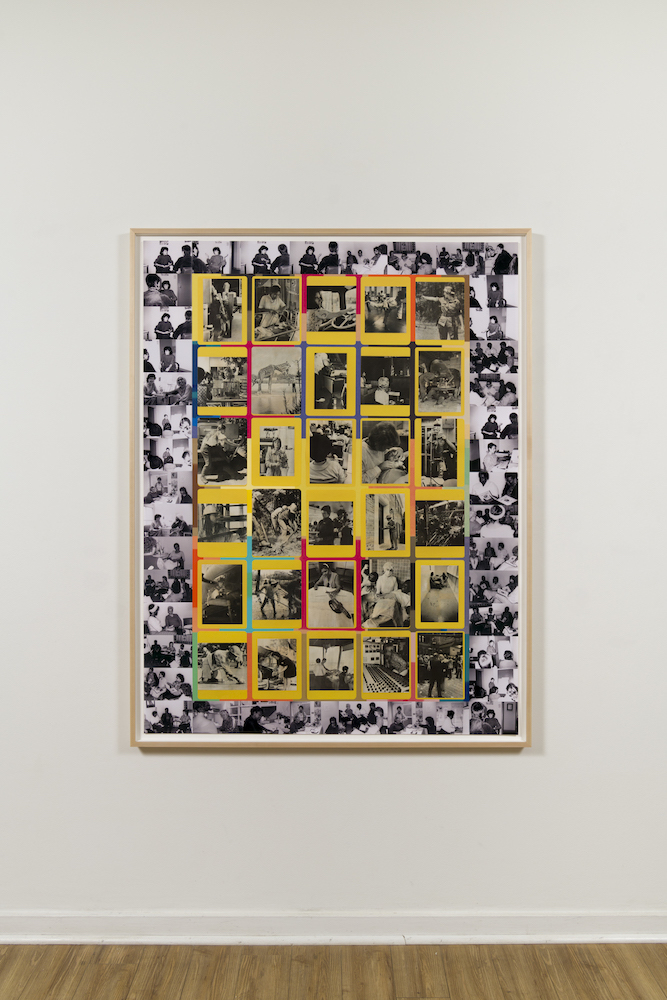 Carmen Winant, “Women at Work (Job Cards),” 2022. sun-bleached construction paper, painter’s tape, inkjet prints, 60 1⁄4 x 46 inches, photo by Jaime Alvarez, courtesy of the artist, commissioned by The Print Center, Philadelphia.
Carmen Winant, “Women at Work (Job Cards),” 2022. sun-bleached construction paper, painter’s tape, inkjet prints, 60 1⁄4 x 46 inches, photo by Jaime Alvarez, courtesy of the artist, commissioned by The Print Center, Philadelphia.
Organized by Ksenia Nouril, PhD, The Print Center’s Jensen Bryan Curator, and supported by The Pew Center for Arts & Heritage, “A Brand New End” deals with the incredibly sensitive and heavy subject matter of domestic violence, substance abuse, and the work of the support systems that aid in helping women restart their lives and surive. The material is handled with great care, a generosity that was also offered to visitors. On the second floor covering opposite walls is a constellation of newspaper and magazine clippings from local and national outlets telling stories of domestic violence. It’s a devastating avalanche of the very real, often fatal, threats women and children can face at home. Chairs line one wall, offering a chance to rest, while the middle of the room is occupied by a table filled with live green houseplants. Paired with corkboards of empowering pins and badges sourced from WIT and NCADV, as well as take-home colorful print-outs on abusive power and control relationships, it’s a reminder that this is a living archive. In the back upstairs room, multiple slide projectors showcase the community aspect of WIT’s mission, the everyday work of helping women and their families, and the actions of raising awareness.
Whitewall spoke with Winant about embarking on a project of this magnitude, scope, and difficulty.
WHITEWALL: What was the starting point for this show? How did you start working with WIT and NCADV?
CARMEN WINANT: I had known about Women in Transition, and I grew up in Philadelphia. I so often gravitate towards material, archival or otherwise, that revolves around or centers in feminist joy. I think I do that as a mode of survival myself. I want some of that. I want that to rub off on me.
I didn’t know what I would find in the archive, and I was terrified of what I might find. Of course, for the most part, there are no images of horror because that’s not what women and vulnerable people who are seeking out support need. It became as much a project about those support structures, and those modes and methods of feminist survival, and even joy. But, of course, coursing under all of that was gender violence and gender terror.
I went inch by inch. And with the support and collaboration of these organizations themselves, which really emboldened me. It was meaningful for me to look at how we understand these support organizations now functioning, which was in a lot of ways a byproduct of early radical feminism. So many of these women found each other because they were in women’s liberation groups and consciousness-raising groups.
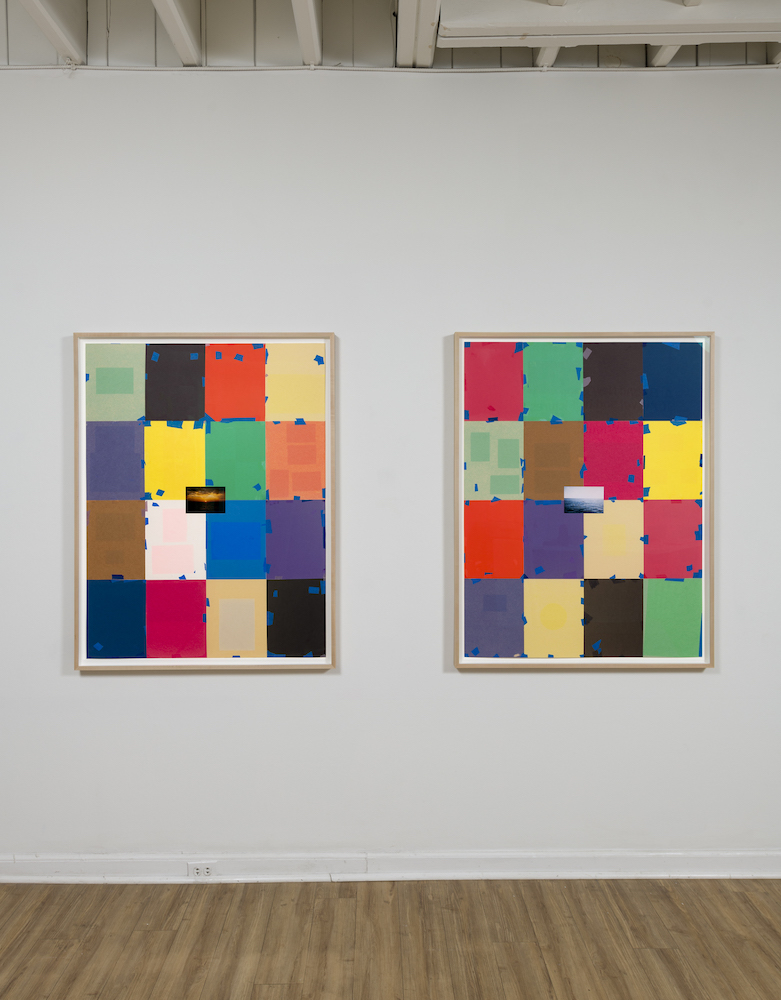 Carmen Winant, “Women’s blueprint for survival (2) and (1),” 2022, sun-bleached construction paper, painter’s tape, inkjet prints, each 47 1⁄2 x 36 inches, photo by Jaime Alvarez, courtesy of the artist, commissioned by The Print Center, Philadelphia.
Carmen Winant, “Women’s blueprint for survival (2) and (1),” 2022, sun-bleached construction paper, painter’s tape, inkjet prints, each 47 1⁄2 x 36 inches, photo by Jaime Alvarez, courtesy of the artist, commissioned by The Print Center, Philadelphia.
WW: This was the first time that you had worked with these kinds of organizations, right? Something outside of a collecting institution or someone’s personal collection of images.
CW: Yes. We spent a lot of time talking about that because it was new territory for me, sort of this in-between category. For a long time, I thought of myself working with this capital “I” institutions, research universities, or outlier archives that are under people’s beds or in their closets in their homes. To work with these mid-size, long-standing, organizations was a new prospect and I had to feel my way through it.
WW: What did you expect to find, and then, what did you find?
CW: I was naively expecting initially to find terrifying images of violence, trauma, and abuse. While some of that material does exist, largely in the newspaper clippings that were independently collected by both organizations, for the most part, these are organizations that are invested in offering women and other vulnerable people agency, dignity, esteem, and empowerment. Those are the tools that are going to be there and that’s the material that’s going to be there.
I was really compelled by all of the photography that I found, which came in so many different forms. There are 35mm slides, 4×6 prints of workshops and training, and the hotline operating. The images in the newspapers were slightly different, images from trips with the sun setting and sun rising, seascape images. Photography was being used as a pedagogical tool for teaching and learning. Those are appropriated images themselves, so there is this double or meta-appropriation happening there, with me using them on top of that.
I was really moved. I was surprised by the content of the images and the form, that there were so many photographs, and the importance of photography as a knowledge-making tool but also as a teaching tool.
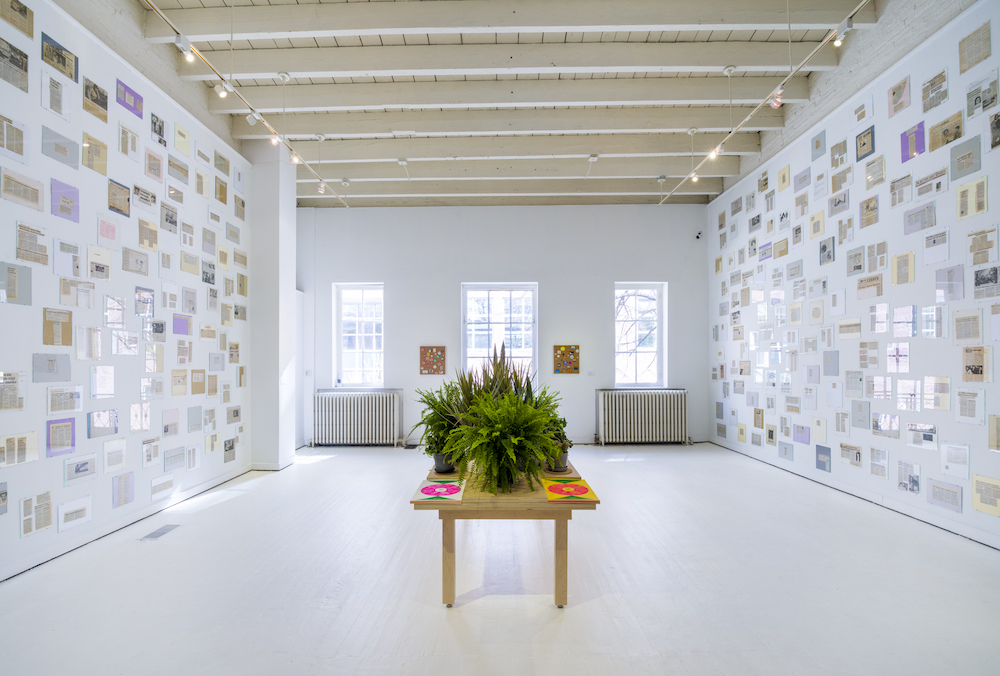 Carmen Winant, installation view of “Newspaper clippings, 1972–2004, from the collections of Women in Transition, NCADV, and the artist,” 2022, newspaper clippings, construction paper, dimensions variable, photo by Jaime Alvarez, courtesy of the artist, commissioned by The Print Center, Philadelphia.
Carmen Winant, installation view of “Newspaper clippings, 1972–2004, from the collections of Women in Transition, NCADV, and the artist,” 2022, newspaper clippings, construction paper, dimensions variable, photo by Jaime Alvarez, courtesy of the artist, commissioned by The Print Center, Philadelphia.
WW: I love the first floor and your choice to make these bulletin boards. It really struck me, the way that the colored paper was sun-bleached, and seeing the blue tape still there. It’s a little nerve-wracking to start engaging with this material as a viewer, but those put me in a comfortable space.
CW: I’m happy to hear that. It was a fine line to walk. It was important for us that we weren’t euphemistically talking about domestic violence or gender violence, and, at the same time, because the organizations themselves were so much the protagonists of the project, we were taking cues from them around how to think through this material visually and actually what would be serviceable to people.
That goes too with the plants upstairs that were figuratively taken from their offices, which were so full of plants, things that are alive, growing, and flourishing, literally making oxygen. The pieces downstairs were derived from the childcare room at Women in Transition, which is beautiful. It’s the first room you see when you walk in because these feminist organizations have childcare rooms. It was so full of color and there were all these pieces of construction paper in the window. That was sort of my cue for thinking through what those objects were, forming my take.
WW: And those two images of the sunrise and the sunset. That was so powerful.
CW: When I came upon those images, I was alone in a storage unit in Denver and they were just in an envelope. There were three images, I used two of them. It was marked on the envelope, “Survivors Trip to the Sea.” I asked the folks at NCADV about them, but they didn’t know what they were. There is so much material there that has gone through multiple directors. There is not necessarily institutional knowledge about everything that’s there. There is some mystery around it. Being able to see it in a survivor’s eyes in some literal way and looking towards the sea as this beautiful expansive space is really something. It says something more for me, more than images that feel more direct or sensational in some cases.
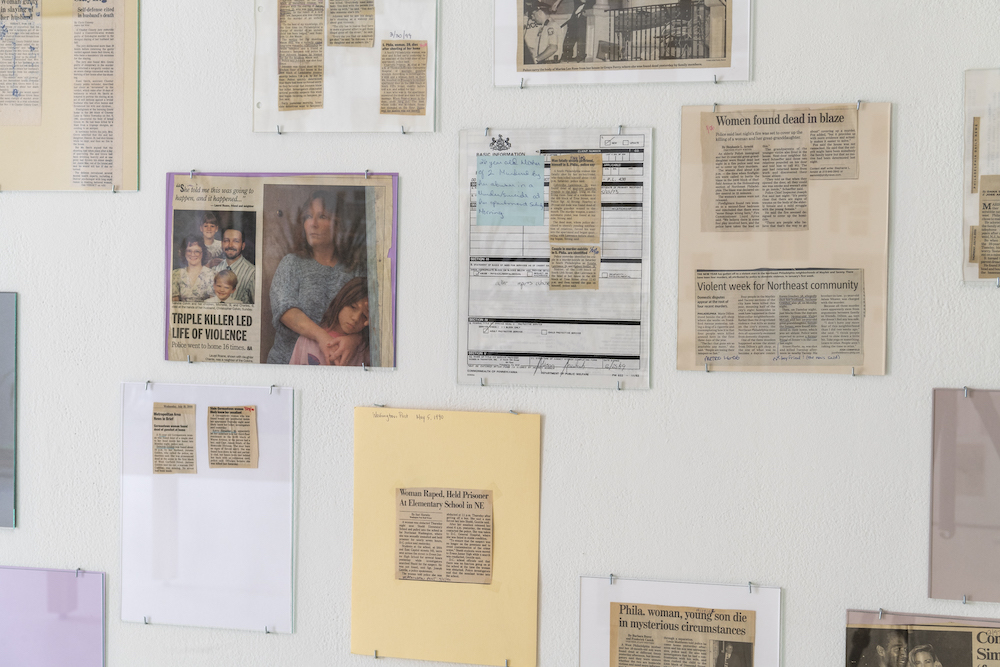 Carmen Winant, installation view of “Newspaper clippings, 1972–2004, from the collections of Women in Transition, NCADV, and the artist” (detail), 2022, newspaper clippings, construction paper, dimensions variable, photo by Jaime Alvarez, courtesy of the artist, commissioned by The Print Center, Philadelphia.
Carmen Winant, installation view of “Newspaper clippings, 1972–2004, from the collections of Women in Transition, NCADV, and the artist” (detail), 2022, newspaper clippings, construction paper, dimensions variable, photo by Jaime Alvarez, courtesy of the artist, commissioned by The Print Center, Philadelphia.
WW: On the second floor there are the two walls with clippings of magazine and newspaper stories. What made you want to do that? When you see these stories of violence accumulated, it’s so devastating.
CW: When I was working on that portion of it, going through all the material at the two distinct archives, gathering and making sense of it together, making decisions about what should go in the piece, the larger installation, I totally disassociated. The stories—it’s unbearable. After it went up, I have just been weeping ever since. It’s so amazing and intense how our bodies compartmentalize. My body was like, just get through this. I felt so much relief after the project went up. You feel relieved when the thing gets done. But I also felt a tremendous amount of relief that the people that were involved with me on the show, some of them survivors themselves, others working in support organizations, and as both, that they felt affirmed by it. I didn’t realize what an intense knot of anxiety I had been carrying around. So, for them to feel excited and affirmed by the work was important.
That was a piece that continued to evolve because I kept on finding them in pieces and parts of the larger archive. It became apparent that there were hundreds, if not thousands, of these newspaper clippings that had been saved by both directors of these organizations, which felt like such a clue for me in terms of what they were holding on to and working to document and catalog: a kind of cultural understanding, a mediation of domestic violence. It started as a small piece and then it kept growing and growing in reflection of what I was finding. It was one wall and then it was two walls. I had to pare down the material.
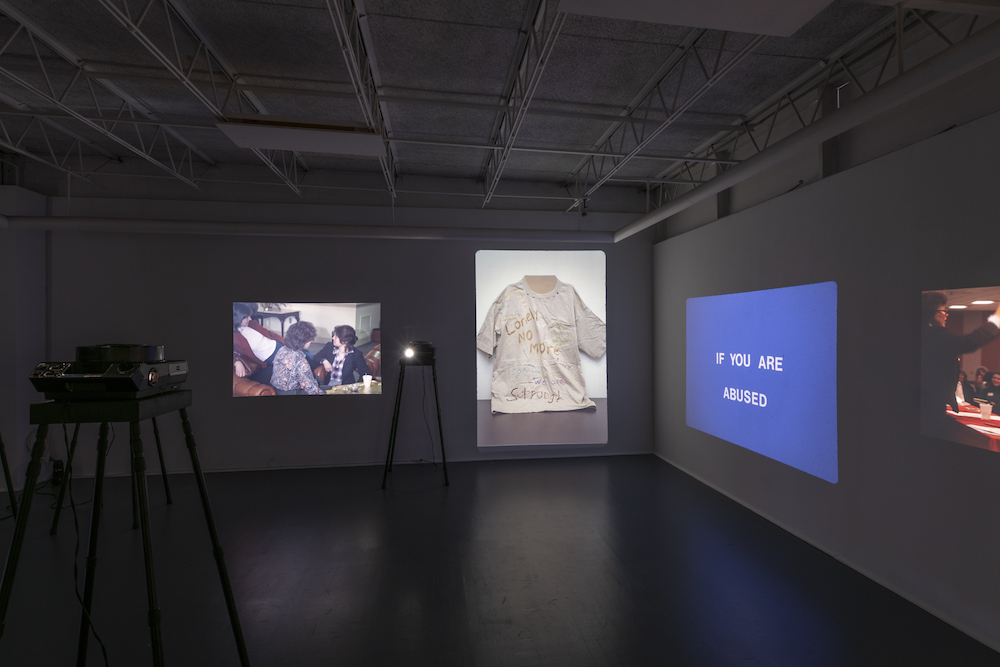 Carmen Winant, “Healing from trauma is a process that involves joy and coalition,” 2022, seven 35mm slide projectors and 560 slides, dimensions variable, photo by Jaime Alvarez, courtesy of the artist, commissioned by The Print Center, Philadelphia.
Carmen Winant, “Healing from trauma is a process that involves joy and coalition,” 2022, seven 35mm slide projectors and 560 slides, dimensions variable, photo by Jaime Alvarez, courtesy of the artist, commissioned by The Print Center, Philadelphia.
WW: In addition to the exhibition at The Print Center, there’s been public programming, a series of interventions on bus shelters around Philadelphia, and a forthcoming book this fall. Can you tell us more about putting those aspects together?
CW: The project was always conceived, from the beginning, of being more than one thing: the exhibition, which would come first, and then the programs, the public intervention, the bus shelter images, and the book.
We had to make our way through the exhibition, which was a big undertaking, and only now are we thinking through the book in a dedicated way since it’s not going to come out until the fall. It isn’t a catalog, there are no installation images, it is its own container for this newly centralized archive with a number of different voices. There will be 10-12 short entries of survivors, support workers, activists, scholars, artists, etc. who will be responding to the images. It’s more of its own art project.
I am a big fan of books. They can travel and can be cheap, and there is a relationship between bookmaking and organizations like this in the first place, who are printing early and often. There are pamphlets and dedicated books to be able to disseminate to people who might need their service. It has always felt to me like a logical point of relation.
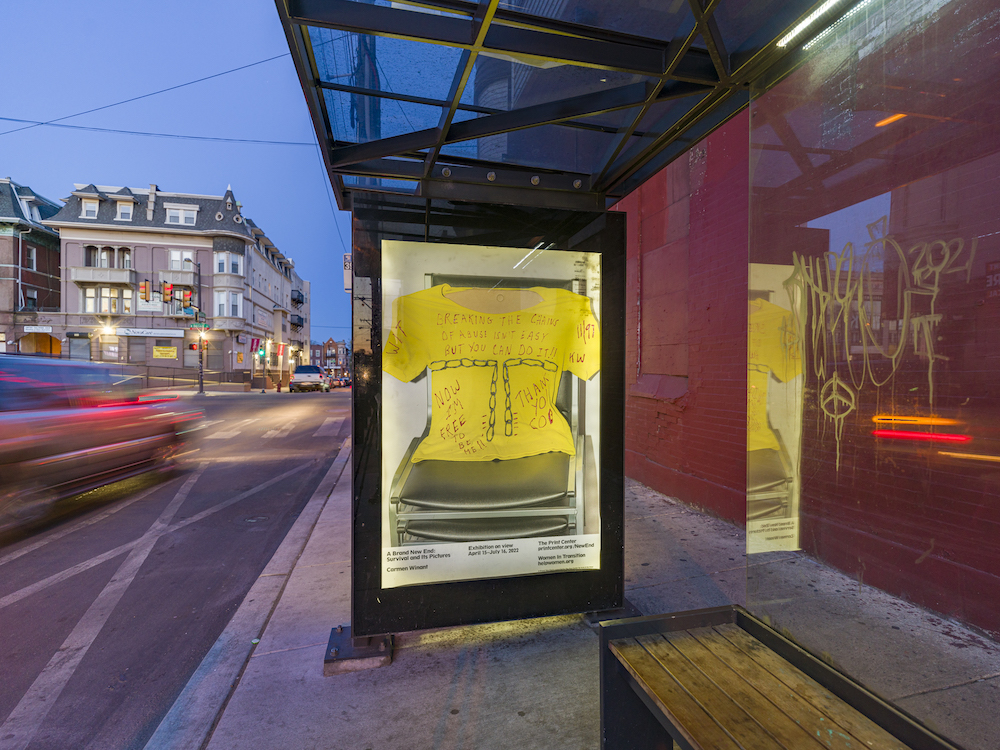 Carmen Winant, Bus shelter poster, 2022, photo by Jaime Alvarez, courtesy of the artist, commissioned by The Print Center, Philadelphia.
Carmen Winant, Bus shelter poster, 2022, photo by Jaime Alvarez, courtesy of the artist, commissioned by The Print Center, Philadelphia.






